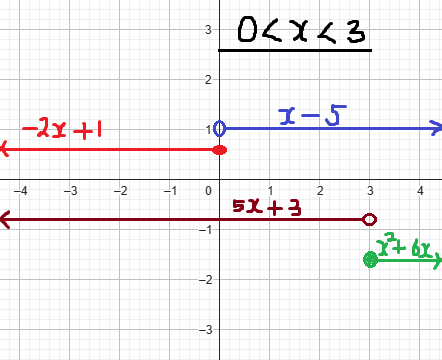(19.) Find the sum function: (f + g)(x) if
$ f(x) = \begin{cases} 5x + 3 \hspace{18mm} \text{if} \hspace{5mm} x \lt 3 \\[3ex] x^2 + 6x \hspace{15mm} \text{if} \hspace{5mm} x \ge 3 \end{cases} \\[5ex] $ and
$ f(x) = \begin{cases} -2x + 1 \hspace{12mm} \text{if} \hspace{5mm} x \le 0 \\[3ex] x - 5 \hspace{20mm} \text{if} \hspace{5mm} x \gt 0 \end{cases} \\[5ex] $
Let us review a visual representation of these functions.

1st Step
Compare domains: domain of 1st piece of $f(x)$ and domain of 1st piece of $g(x)$
x < 3 and x ≤ 0
x ≤ 0 also includes x < 3
∴ x ≤ 0 becomes the first domain of the sum function
2nd Step
Determine the sum function for the first domain (1st piece)
$ (f + g)(x) \\[3ex] = f(x) + g(x) \\[3ex] = (5x + 3) + (-2x + 1) \\[3ex] = 5x + 3 - 2x + 1 \\[3ex] = 3x + 4 \\[3ex] $ 3rd Step
Compare domains: domain of 1st piece of $f(x)$ and domain of 2nd piece of $g(x)$
x < 3 and x > 0
⇒ x < 3 and 0 < x
⇒ 0 < x < 3
This becomes the second domain of the sum function
4th Step
Determine the sum function for the second domain (2nd piece)
$ (f + g)(x) \\[3ex] = f(x) + g(x) \\[3ex] = (5x + 3) + (x - 5) \\[3ex] = 5x + 3 + x - 5 \\[3ex] = 6x - 2 \\[3ex] $ 5th Step
Compare domains: domain of 2nd piece of $f(x)$ and domain of 2nd piece of $g(x)$
x ≥ 3 and x > 0
x ≥ 3 also includes x > 0
∴ x ≥ 3 becomes the third domain of the sum function
6th Step
Determine the sum function for the third domain (3rd piece)
$ (f + g)(x) \\[3ex] = f(x) + g(x) \\[3ex] = (x^2 + 6x) + (x - 5) \\[3ex] = x^2 + 6x + x - 5 \\[3ex] = x^2 + 7x - 5 \\[3ex] $ The Piecewise Function of the Sum Function is:
$ (f + g)(x) = \begin{cases} 3x + 4; \hspace{3.9em} x \le 0 \\[3ex] 6x - 2; \hspace{4.1em} 0 \lt x \lt 3 \\[3ex] x^2 + 7x - 5; \hspace{2em} x \ge 3 \end{cases} $
$ f(x) = \begin{cases} 5x + 3 \hspace{18mm} \text{if} \hspace{5mm} x \lt 3 \\[3ex] x^2 + 6x \hspace{15mm} \text{if} \hspace{5mm} x \ge 3 \end{cases} \\[5ex] $ and
$ f(x) = \begin{cases} -2x + 1 \hspace{12mm} \text{if} \hspace{5mm} x \le 0 \\[3ex] x - 5 \hspace{20mm} \text{if} \hspace{5mm} x \gt 0 \end{cases} \\[5ex] $
Let us review a visual representation of these functions.

1st Step
Compare domains: domain of 1st piece of $f(x)$ and domain of 1st piece of $g(x)$
x < 3 and x ≤ 0
x ≤ 0 also includes x < 3
∴ x ≤ 0 becomes the first domain of the sum function
2nd Step
Determine the sum function for the first domain (1st piece)
$ (f + g)(x) \\[3ex] = f(x) + g(x) \\[3ex] = (5x + 3) + (-2x + 1) \\[3ex] = 5x + 3 - 2x + 1 \\[3ex] = 3x + 4 \\[3ex] $ 3rd Step
Compare domains: domain of 1st piece of $f(x)$ and domain of 2nd piece of $g(x)$
x < 3 and x > 0
⇒ x < 3 and 0 < x
⇒ 0 < x < 3
This becomes the second domain of the sum function
4th Step
Determine the sum function for the second domain (2nd piece)
$ (f + g)(x) \\[3ex] = f(x) + g(x) \\[3ex] = (5x + 3) + (x - 5) \\[3ex] = 5x + 3 + x - 5 \\[3ex] = 6x - 2 \\[3ex] $ 5th Step
Compare domains: domain of 2nd piece of $f(x)$ and domain of 2nd piece of $g(x)$
x ≥ 3 and x > 0
x ≥ 3 also includes x > 0
∴ x ≥ 3 becomes the third domain of the sum function
6th Step
Determine the sum function for the third domain (3rd piece)
$ (f + g)(x) \\[3ex] = f(x) + g(x) \\[3ex] = (x^2 + 6x) + (x - 5) \\[3ex] = x^2 + 6x + x - 5 \\[3ex] = x^2 + 7x - 5 \\[3ex] $ The Piecewise Function of the Sum Function is:
$ (f + g)(x) = \begin{cases} 3x + 4; \hspace{3.9em} x \le 0 \\[3ex] 6x - 2; \hspace{4.1em} 0 \lt x \lt 3 \\[3ex] x^2 + 7x - 5; \hspace{2em} x \ge 3 \end{cases} $
(20.)